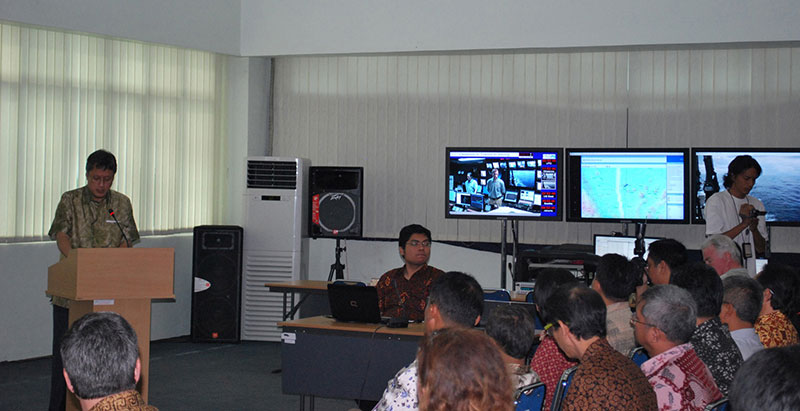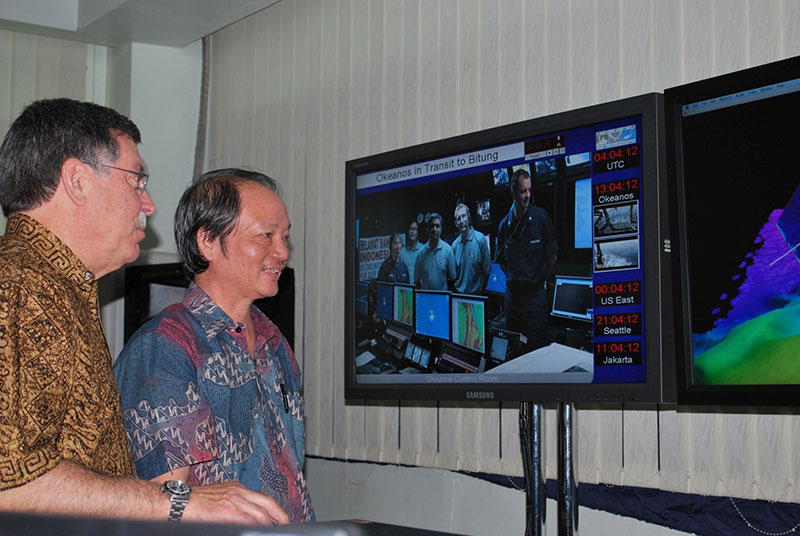
by Dr. Michael A. Purwoadi, Control System Engineer, Indonesian Agency for Assessment and Application of Technology
June 25, 2010

Agency for Maritime and Fishery Research Chairman Gellwynn Jusuf opens the Jakarta ECC dedication ceremony. Image courtesy of the NOAA Office of Ocean Exploration and Research, INDEX-SATAL 2010. Download larger version (jpg, 911 KB).
Full operations at the Jakarta Exploration Command Center (ECC) commenced yesterday, June 24, with the start of the INDEX-SATAL 2010 expedition. During the expedition, scientists based at the Jakarta ECC will monitor video and data feeds coming off of NOAA Ship Okeanos Explorer and the Agency for the Assessment and Application of Technology's research vessel, Baruna Jaya IV, as both vessels explore areas known to be very volcanically active around the Sangihe and Talaud islands. With the ability to monitor live incoming feeds, and communicate in real time with the Okeanos Explorer, scientists and participants at the Jakarta ECC are utilizing telepresence to explore the ocean for the first time!
A very high bandwidth internet connection allows the Jakarta ECC to support telepresence technology – composed of three plasma screens for viewing video transmitted from the ship and an IP-based intercom and teleconference system that allows real time audio-video communication with the Okeanos Explorer and other ECCs, such as those in Seattle and at the University of New Hampshire.
Developing the Jakarta ECC and bringing it online was no small feat! Development of the infrastructure took about a year and involved many Indonesian and international institutions, including the Agency for Assessment and Application of Technology, the Bandung Institute of Technology, the Trans Euroasia Information Network program, and Transpac2. Infrastructure such as Internet-2 connectivity spans from the United States to hubs located in Tokyo and Hong Kong, and finally into Indonesia and the Agency for Maritime and Fishery Research building in Ancol (10 kilometers from the heart of Jakarta) where the Jakarta ECC resides.

Co-principal investigators Steve Hammond (left) and Sugiarta Wirasantosa (right) chat with Okeanos Explorer team members via telepresence. Image courtesy of the NOAA Office of Ocean Exploration and Research, INDEX-SATAL 2010. Download larger version (jpg, 1.3 MB).
The newest of six ECCs, and the first located in another country, the Jakarta ECC was officially opened on June 18, 2010, by Chairman of the Agency for Maritime and Fishery Research after nearly a year of development and preparation. Developed as part of a science and technology partnership between the Republic of Indonesia and the United States, the Jakarta ECC will enable scientists located in Jakarta to participate in real time in expeditions conducted by via the Okeanos Explorer – during the INDEX-SATAL 2010 expedition and in coming years.
As part of the partnership, the Okeanos Explorer is conducting her maiden expedition in Indonesian waters and will use the Little Hercules remotely operated vehicle to provide – for the first time – a glimpse of deepwater biodiversity in the waters of the Sangihe Talaud Region.